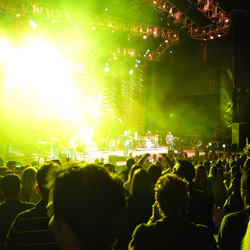
Reduced to Subterfuge
Some of the worst offenders are clubs.
I think I have only encountered a minority of DJs in my entire life who didn’t run the outputs of their mixers solidly into the red and there’s not much you can do with the signal after that.
Engineers are thus reduced to subterfuge and doctor the controls/meters so that even when they are solidly into the red the output signal is still reasonable.
In my mind, distortion means twisting away from truth. Distortion is the opposite of fidelity and is alarmingly easy to end up with.
It comes in many varieties and can be introduced at any point in the signal path.
A common event is over-driving either the input or output levels as in the previously mentioned example. Another is the source material itself.
All these points can be summed up as involving the maintenance of signal path integrity. I have left the most damning example of distortion introduction to last, which is of course the famed loudspeaker.
Notwithstanding operator abuse, the intrinsic distortion figures of loudspeakers working at just 10 percent of their rated power (when does that happen in real life?) dwarf anything that can be found in other parts of the signal path that are not being overdriven.
There are, it should be noted, some very guilty loudspeakers out there.
Odd Harmonics
Loudspeakers can introduce distortion with harmonic resonance, which can sometimes be greater than the fundamental. Odd harmonics seem to be musically worse than even harmonics. And neither is obviously best.
Another common occurrence is ringing, which is basically the cone or diaphragm that carries on bouncing around long after the original signal has ceased.
The cure for this is more dampening. However, the most frequent source of distortion is over-driving the loudspeakers.
I’m not talking about giving them more watts than their voice coils are able to handle temperature-wise, but the sheer inability of most loudspeakers to deliver clean sound at just 50% of their rated power, bearing in mind how large the harmonic distortion numbers are at the AES standard of 10 percent of rated power.
And whilst I am on this subject, I really must take extreme exception to probably the most ridiculous measurement parameter that has been introduced in the last 20 years, namely the terminal SPL figure. This is a function of power rating, sensitivity and power compression.
